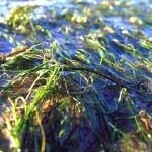Plants herbaceous, glabrous, perennial, submersed in saline water, dioecious. Rhizomes creeping, simple or branched, with one or more roots and a short erect stem at each node. Stems with 1-4 leaves and subtended by scarious elliptic or ovate scales. Leaves alternate or appearing opposite because of reduced inter-nodes, sessile, divided into a blade and a sheath; sheath persisting longer than the blade, leaving a circular scar when shed; blades linear, compressed, terete, entire except apically, often narrowed at the base, 3-nerved, the midrib conspic-uous, the lateral nerves inconspicuous, each ending in a tooth, the apex 2-3 toothed. Flowers terminal, solitary, each enclosed in a leafy bract; perianth absent; staminate flowers stalked consisting of 2 anthers attached to the filament at different levels and joined dorsally at their base, the anthers 4-thecate, de-hiscing vertically; carpellate flowers subsesssile, consisting of two distinct uni-ovulate carpels, each carpel with a distinct style. Fruits achene-like with a stony pericarp, slightly compressed, subglobose to ovoid, with a short beak.
Marine, rarely estuarine, submerged sometimes intertidal herbs. Rhizome herbaceous, monopodially branched, with 1 or more unbranched roots and a short, erect stem at each node; scales oblong. Stem with 1–4 leaves. Leaf sheath appearing similar in width to blade, persistent after blade is shed, leaving an open circular scar; margins incurved. Leaf blade linear, flat, narrowed at base, entire; apex variable in outline; longitudinal veins 3, only midvein conspicuous, widened or furcate at apex. Flowers solitary, terminal, enclosed in a normal leaf; axillary bud of penultimate leaf developing into a leafy shoot replacing original axis. Male flower pedicellate; anthers at different levels, dorsally connate in lower parts. Female flower subsessile; carpels free; styles long, unbranched. Fruits ovoid to subgloboseovoid; pericarp hard, stony, smooth with colour ornamentations, beaked.
Submerse aquatic herbs; rhizome creeping, monopodial, with 2 vascular bundles; at each node 1-several roots and a short erect stem bearing 1– 4 leaves. Leaves with sheath 1– 6 cm long, semi-persistent, when shed leaving circular scar; blade linear, entire, narrowed at base, with 3 veins and conspicuous midrib which is widened or furcate at apex. Flowers solitary and terminal, enclosed in a leaf similar to others; bud in axil of penultimate leaf develops into prolongation of main axis giving rise to a sympodium; staminate flower subsessile, of 2 anthers attached at different levels, joined basally; carpellate flowers subsessile, of 2 free ovaries, each with a long style. Fruit subglobose-ovoid, shortly beaked, ± compressed, with stony pericarp.
Stems erect, subtended by elliptic or ovate scales. Leaves 1--4; blade flattened, apex 2--3-toothed, lacunae absent; veins 3, midvein conspicuous, widened distally, lateral veins inconspicuous, each ending in tooth. Inflorescences solitary. Flowers axillary to leafy bract, inflated sheath absent. Staminate flowers: anthers attached to axis at different levels. Pistillate flowers nearly sessile, styles not divided into stigmas. Fruits achenelike, slightly compressed, nearly globose to ovoid.
Rhizomes branched, rooting at nodes. Shoots erect, with 2 scales at base. Leaves 1-4, alternate, flattened, linear, 3-veined, margin toothed at apex; sheaths compressed, auriculate, ligulate. Flowers solitary and terminal, enclosed in a leaf. Male flowers consisting of 2 unequally inserted anthers, without filament; pollen filiform. Female flowers subsessile; style simple. Fruitlet laterally subcompressed, with bony pericarp, beaked.

